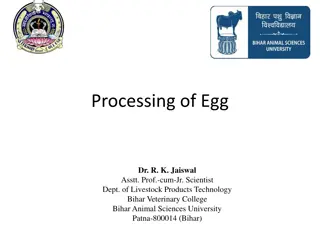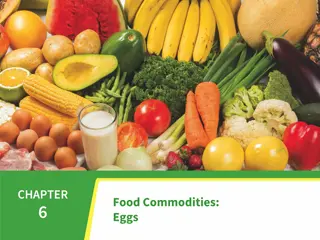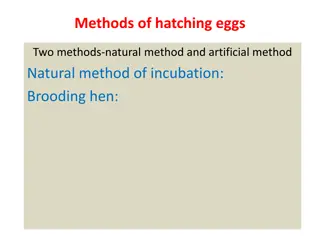Mastering Egg Cookery: A Comprehensive Guide to Eggs
Explore the world of eggs with this detailed guide covering egg composition, purchasing and storing tips, cooking methods, nutritional benefits, and food safety practices. Learn how to grade, handle, and cook eggs to perfection, whether you're frying, boiling, or baking. Discover the versatility of eggs in various dishes, from breakfast classics to decadent desserts. Enhance your egg cookery skills and elevate your culinary creations with the knowledge and techniques shared in this instructional material.
Download Presentation

Please find below an Image/Link to download the presentation.
The content on the website is provided AS IS for your information and personal use only. It may not be sold, licensed, or shared on other websites without obtaining consent from the author.If you encounter any issues during the download, it is possible that the publisher has removed the file from their server.
You are allowed to download the files provided on this website for personal or commercial use, subject to the condition that they are used lawfully. All files are the property of their respective owners.
The content on the website is provided AS IS for your information and personal use only. It may not be sold, licensed, or shared on other websites without obtaining consent from the author.
E N D
Presentation Transcript
Eggs and Breakfast Egg Cookery Skills John Alunni
Learning Objectives After this class, you should be able to complete the following Learning Objectives Understand the composition of eggs 20.1 Purchase and store eggs properly 20.2 Apply various cooking methods to eggs 20.3
Instructional Objectives Egg Cookery Class 1 Understand egg grading, packaging, and sizes Prepare eggs Flip eggs in a pan Cook eggs to proper degrees of doneness Plate, garnish, and serve eggs Understand the composition of eggs. Understand egg substitutes and uses Understand nutritional value of eggs Purchase, store, and handling of eggs Food safety when handling eggs Apply dry heat cooking methods to eggs
Eggs Great source of protein Served alone or provide texture, flavor, structure, moisture, nutrition, binding
20.2 Purchasing and Storing Eggs USDA or a state agency Grading Eggs Based on quality not size AA, A, or B
Egg Uses Per Grade What would you use these for? http://www.fallharvestproducts.com/usrimage/gradelabels300.jpg
Egg Storage Do not leave eggs out for more than an hour Older eggs Use for boiling Shell removes easier Store away from strong flavored foods Will absorb odors Raw in shell 40 degrees or below In original case or carton 4-5 weeks beyond pack date with no significant quality loss Can be beaten and stored in freezer for up to one year Egg whites and yolks 4 days under refrigeration
Egg Safety Eggs are a TCS Food Bacteria Salmonella Some bacteria may remain on shell after processing Minimize shell contact with liquid egg USDA pasteurization 140 degrees for 3.5 minutes Hold egg dishes at below 41 degrees or above 135 degrees Room temp less than an hour
20.2 Purchasing and Storing Eggs Improper cooking or storing may lead to food-borne illness Never leave at room temperature for more than an hour prior to use
20.2 Purchasing and Storing Eggs Eggs can be pasteurized at 140 F for 3 minutes Pasteurization Heating to destroy pathogenic bacteria
Cooking Methods for Eggs Cooked by almost any method Dry heat: Baking, sauteeing, pan frying Moist heat: In shell boiling, steaming, or poaching http://1.bp.blogspot.com/_wjO9ZSr8ZTA/TNWNFmaPcFI/AAAAAAAAJQw/20zah6zkmkM/s800/SSWF-BakedEggs1.jpg http://www.ricaperalejo.ph/wp-content/uploads/2013/02/fried-egg.jpg https://encrypted-tbn2.gstatic.com/images?q=tbn:ANd9GcSi0GzM0qgfrqijkapMjaKArbcS3ZCwqGOYDhdpD5rjt7mracRi
Scrambled Eggs Procedure 1. Break eggs into mixing bowl 2. Season with salt and pepper 3. Add 1 tsp milk or cream per egg 4. Whisk 5. Heat pan and add clarified butter 6. When butter sizzles, add egg all at once 7. As eggs begin to set, stir gently with rubber spatula 8. Lift cooked portion to let uncooked flow under 9. Sprinkle on cheese and herbs 10. If using vegetables or meats, pre cook them and add near end of cooking
Scrambled Eggs http://ts1.mm.bing.net/images/thumbnail.aspx?q=4597453955336092id=10db9a27e45e2c5eab002276e15dfa6a Ingredients that go well with scrambled eggs? Ingredient considerations, moisture content, flavor, and color Scrambled eggs Scrambled with choice of ingredients
Omelets: Usually prepared as individual servings using two or three eggs. Cooked eggs are usually folded around or filled with a savory mixture. Can use vegetables, seafood, dairy, meats, and starches. Ingredients may need to be cooked prior to making the omelet. These filling ingredients should be mise en place prior to cooking the omelet. Pan should be shallow, non stick, with gently sloping sides. A rubber spatula can be used to loosen and flip the omelet. Always let eggs set prior to filling and flipping.
Procedure for Making Omelets 1. Fully cook meats and blanch vegetables 2. Heat pan and add clarified butter 3. Whisk eggs and season with salt and pepper 4. Pour eggs into pan 5. Flow raw egg under cooked. Allow to set 6. Spoon ingredients on top of eggs 7. Flip in half with spatula or while sliding from pan to plate 8. Garnish
Hard and soft boiled eggs: The difference between hard and soft boiled eggs is time. Eggs cooked in shell should never be boiled or overcooked or the yolk will turn green. Soft cooked 4 to 6 minutes. Hard cooked 12 to 15 minutes. Run water over eggs immediately to reduce carry over cooking. Crack large end of egg to serve. Eggs three or more days old are easier to peel.
Class Hands On Cracking eggs Sauteeing eggs and degrees of doneness Scrambled eggs Omelettes Hard cooked eggs























